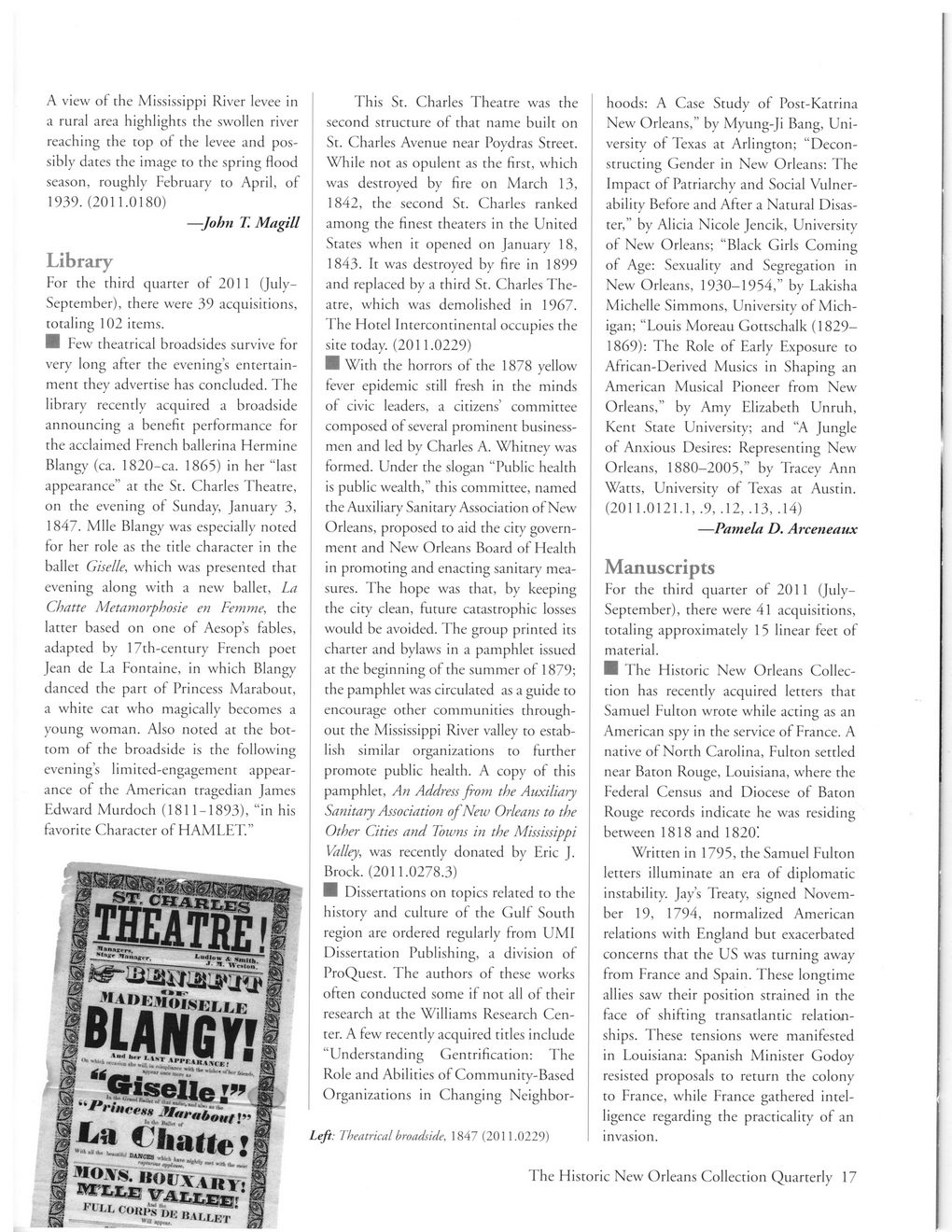This text was obtained via automated optical character recognition.
It has not been edited and may therefore contain several errors.
A view of the Mississippi River levee in a rural area highlights the swollen river reaching the top of the levee and possibly dates the image to the spring flood season, roughly February to April, of 1939. (2011.0180) —John T. Magill Library For the third quarter of 2011 (July-September), there were 39 acquisitions, totaling 102 items. H Few theatrical broadsides survive for very long after the evening’s entertainment they advertise has concluded. The library recently acquired a broadside announcing a benefit performance for the acclaimed French ballerina Hermine Blangy (ca. 1820-ca. 1865) in her “last appearance” at the St. Charles Theatre, on the evening of Sunday, January 3, 1847. Mile Blangy was especially noted for her role as the title character in the ballet Giselle, which was presented that evening along with a new ballet, La Chatte Metamorphosie en Femme, the latter based on one of Aesop’s fables, adapted by 17th-century French poet Jean de La Fontaine, in which Blangy danced the part of Princess Marabout, a white cat who magically becomes a young woman. Also noted at the bottom of the broadside is the following evening’s limited-engagement appearance of the American tragedian James Edward Murdoch (181 1-1893), “in his favorite Character of HAMLET.” J 5 ■'I. Wnlon WAAfGKfi SI “ I wlselle ii? ES V b.*, * ■*« • This St. Charles Theatre was the second structure of that name built on St. Charles Avenue near Poydras Street. While not as opulent as the first, which was destroyed by fire on March 13, 1842, the second St. Charles ranked among the finest theaters in the United States when it opened on January 18, 1843. It was destroyed by fire in 1899 and replaced by a third St. Charles Theatre, which was demolished in 1967. The Hotel Intercontinental occupies the site today. (2011.0229) I With the horrors of the 1878 yellow fever epidemic still fresh in the minds of civic leaders, a citizens’ committee composed of several prominent businessmen and led by Charles A. Whitney was formed. Under the slogan “Public health is public wealth,” this committee, named the Auxiliary Sanitary Association of New Orleans, proposed to aid the city government and New Orleans Board of Health in promoting and enacting sanitary measures. The hope was that, by keeping the city clean, future catastrophic losses would be avoided. The group printed its charter and bylaws in a pamphlet issued at the beginning of the summer of 1879; the pamphlet was circulated as a guide to encourage other communities throughout the Mississippi River valley to establish similar organizations to further promote public health. A copy of this pamphlet, An Address from the Auxiliary Sanitary Association of New Orleans to the Other Cities and Towns in the Mississippi Valley, was recently donated by Eric J. Brock. (2011.0278.3) H Dissertations on topics related to the history and culture of the Gulf South region are ordered regularly from UMI Dissertation Publishing, a division of ProQuest. The authors of these works often conducted some if not all of their research at the Williams Research Center. A few recently acquired titles include “Understanding Gentrification: The Roie and Abilities of Community-Based Organizations in Changing Neighbor- Left: Theatrical broadside, 1847 (2011.0229) hoods: A Case Study of Post-Katrina New Orleans,” by Myung-Ji Bang, University of Texas at Arlington; “Deconstructing Gender in New Orleans: The Impact of Patriarchy and Social Vulnerability Before and After a Natural Disaster,” by Alicia Nicole Jencik, University of New Orleans; “Black Girls Coming of Age: Sexuality and Segregation in New Orleans, 1930—1954,” by Lakisha Michelle Simmons, University of Michigan; “Louis Moreau Gottschalk (1829— 1869): The Role of Early Exposure to African-Derived Musics in Shaping an American Musical Pioneer from New Orleans,” by Amy Elizabeth Unruh, Kent State University; and “A Jungle of Anxious Desires: Representing New Orleans, 1880-2005,” by Tracey Ann Watts, University of Texas at Austin. (2011.0121.1, .9, .12, .13, .14) —Pamela D. Arceneaux Manuscripts For the third quarter of 2011 (July-September), there were 41 acquisitions, totaling approximately 1 5 linear feet of material. ■ The Historic New Orleans Collection has recently acquired letters that Samuel Fulton wrote while acting as an American spy in the service of France. A native of North Carolina, Fulton settled near Baton Rouge, Louisiana, where the Federal Census and Diocese of Baton Rouge records indicate he was residing between 1818 and 1820! Written in 1795, the Samuel Fulton letters illuminate an era of diplomatic instability. Jay’s Treaty, signed November 19, 1794, normalized American relations with England but exacerbated concerns that the US was turning away from France and Spain. These longtime allies saw their position strained in the face of shifting transatlantic relationships. These tensions were manifested in Louisiana: Spanish Minister Godoy resisted proposals to return the colony to France, while France gathered intelligence regarding the practicality of an The Historic New Orleans Collection Quarterly 17 4 r r

New Orleans Quarterly 2012 Winter (17)